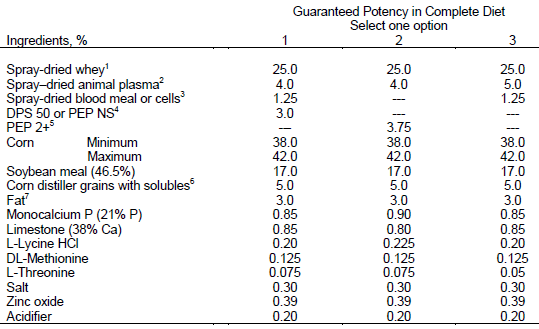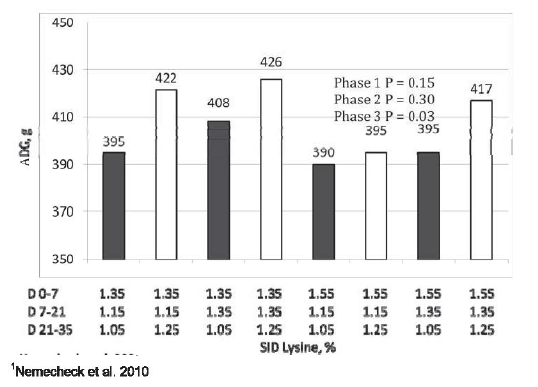



Weaning Management
Bob Goodband, Steve Dritz, Mike Tokach, Joel DeRouchey and Jim Nelssen of Kansas State University have examined lysine requirements and evaluated new protein feed ingredients for today's slightly older weaners in the US, typically weighing 19 to 21kg. They presented some of their research and practical ways to get newly weaned piglets eating at the 2012 Kansas State University Swine Profitability Conference.Without a doubt the swine industry has restructured dramatically in the last decade. Multiple site production has made a large impact on herd health and how we manage flows of weaned pigs. In addition, we have seen weaning ages creep up to an average of 19 to 21 days of age. However, despite these changes, several key management practices remain. These focus around the three primary needs of the weaned pig: feed, water and air (environment).
Procedures needed to be implemented before pigs arrive include setting ventilation controls to allow for the room to dry after washing and disinfection. The room should also be warmed up before pigs arrive and supplemental heat sources should be in place and functioning. Mat feeding for the first three days in the nursery is encouraged. While average daily gain and feed efficiency are not improved with mat feeding, percentage of pig removals has been shown to significantly decrease when pigs are mat fed for three days. Mat feeding for longer periods tends to result in poorer feed efficiency (Potter et al., 2010).
All waterers should be functioning and adjusted to the proper height. Waterers should be set at shoulder height for the smaller pigs in the pen. Cup waterers have been used successfully and reduce water wastage compared to nipple waterers. Using wet/dry feeders as a water source in the nursery phase will result in decreased growth performance of weanling pigs (Nitikanchana et al. 2011). Regardless of whether the first diet after weaning is bagged or in bulk, the feed gate in all feeders should be closed before the first pellets are placed in them. The feed gate then is opened so that a small amount of feed is visible in the feed pan. Placing pelleted feed into empty feeders with the gate open will result in large amounts of feed wastage.
If all of the proper preparatory procedures are performed, the pigs can be left to rest for approximately 36 hours after weaning. Pigs should be observed to ensure that they have found the water source and are beginning to develop feeding behavior. The objective during the period immediately after weaning is to only make minor environmental adjustments and let the pigs rest and acclimate.
By 36 hours after placement, most pigs will have found water and started to exhibit feeding behaviour. However, this is a critical time period to identify pigs that have not eaten or are becoming dehydrated. This may involve hand-feeding a few pellets or using a gruel administered with a syringe; as little as 20 to 30g of feed will provide enough energy to keep the pig from starving. It is critical for small pigs with low body fat reserves to have a readily available energy source.
The authors believe that teaching feeding behaviour to a small number of pigs is essential. The identification of candidate pigs for teaching feeding behaviour is a high priority during the first few days after weaning. This is an area of pig management that requires astute observation of pig behaviour. Pigs that are eating well will begin to have round abdomens, whereas pigs that have not begun to eat will be gaunt. With proper management of the nursery, the number of pigs requiring extra attention will be limited to two to four per cent.
As for feeding programmes, the key concepts are relatively simple and can be applied in a variety of situations around the world. The authors adhere to three key concepts when formulating diets for the weaned pig. Firstly, the economics of today's swine industry dictate that we must adjust pigs to the simplest and relatively lowest cost diets (i.e. grain and soybean meal) as quickly as possible after weaning. Second, we must remember that the newly weaned pig is in an extremely energy-dependent stage of growth and that maximising feed (energy) intake is essential. Third, we must remember the digestive physiology of the pig and formulate the initial diets with highly digestible ingredients that complement the pattern of digestive enzymes secreted pre-weaning.
Reevaluating Lysine Requirements
For many years, attention has been focused on complex and expensive Segregated Early Weaning (SEW) and Transition diets typically fed from weaning to 7kg bodyweight. These diets have relied on relatively high amounts of specialty protein sources such as spray-dried animal plasma, spray-dried whey, fish meal and blood meal. The reason for such high amounts of these ingredients were first to stimulate feed intake, but secondly to provide enough lysine and other amino acids to minimise the use of soybean meal to no more than 12 per cent of the diet. Typical lysine concentrations of these SEW and Transition diets were 1.7 and 1.65 per cent total lysine, respectively (1.56 and 1.50 per cent standardised ileal digestible lysine). However, these diets were formulated for pigs that are approximately three to six days younger and at least one kilogram lighter than pigs weaned today on many farms.
Therefore, the authors' research has focused on re-evaluating lysine and other amino acids requirements and testing new specialty protein sources for weaned pigs. The results of these studies has led us back to our phase 1 diet (Table 1) to replace SEW and Transition diets.

1 Edible grade or equivalent
2 American Proteins, DuCoa, Merricks, or North Central Processors.
3 American Proteins, California Spray Dry, or Merricks.
4 Nutro-Flo (DPS-50) or Tech-Mix (PEP-NS).
5 Tech-Mix (PEP 2+).
6 High quality DDGS with over 26% CP and over 8% fat.
7 Soybean oil or choice white grease.
It is known that dietary lysine is extremely important in weanling pig diets, yet what if we could reduce lysine levels early and maintain them in later diets, would the pig compensate?
To answer this question, the authors conducted a study looking at lysine concentrations in a three phase diet programme (Nemecheck et al., 2010). Within each of the three phases, pigs were fed either a low of typical lysine level in the diet. This resulted in a total of eight dietary lysine treatments. In phase 1, pigs fed the low lysine diet were no different in average daily gain but poorer in feed efficiency than those fed the typical lysine diet. The same response was observed in phase 2 as well. However, in phase 3, there was a lysine response for average daily gain where pigs fed the high lysine diets had greater average daily gain than those fed the low lysine diets (Figure 1).

The ramification of this study is that we can slightly lower lysine levels in our first diet and as long as lysine is adequate in phase 3, performance will not be affected compared to pigs fed typical, high-lysine diets. The second ramification is that with the ability to formulate the first diet fed post weaning to a low lysine level (again maintaining adequate lysine levels in phase 3), we do not need as much of the specialty protein sources, hence saving diet cost.
Evaluating New Protein Sources of Weaners
The second area of research was to evaluate new protein sources for weanling pigs. This arose ironically because of the BP oil spill in the Gulf of Mexico in summer 2010. As a result, select menhaden fish meal became in short supply and its price doubled. In addition, blood meal/cell availability decreased and people were left looking for alternatives to fish meal.
It appears two options exist: crystalline amino acids and intestinal peptide protein sources. To examine the use of crystalline amino acids, the Kansas team conducted a series of experiments. First was to determine the standardised ileal digestible lysine level for pigs in their nursery. Then they used crystalline amino acids to replace fish meal in the diet successfully.
Next, they established ratios of other amino acids to lysine, and finally tested the concept by evaluating several different protein sources with high or low inclusion of crystalline amino acids. Results of these studies suggest that, when formulated properly, crystalline amino acids can replace some of the more expensive specialty protein sources in the diet such as fish meal.
A second alternative to fish meal is intestinal derived protein sources such as DPS 50 (Nutra-flo, Sioux City, lA), and Peptone products (PEP 2+, Pep-NS, Tech-Mix, Stewart, MN.). Either of these three protein sources has been shown to be effective replacements for fish meal in phase 1 and 2 starter diets (Jones et al., 2010, Myers et al., 2010).
The phase 3 diet is the lowest cost diet in the three-phase nursery-feeding programme. However, because consumption of the phase 3 diet is the greatest, it usually accounts for 50 per cent of the total feed cost from weaning to 23kg. Typically, 20 to 23kg of feed is budgeted for pigs during this phase. Thus, cost of this diet is critical to minimise total feed cost while maximising performance in the nursery.
Specialty ingredients, such as spray-dried blood meal, fishmeal or dried whey, are cost-prohibitive because research has failed to indicate improved growth performance from feeding such ingredients in phase 3 (Tokach et al., 2003). This diet should resemble a grow-finish diet, which in most cases will be a simple grain-soybean meal diet. The digestive capacity of the pig by this weight is such that these ingredients are unwarranted; including them will increase feed cost per pig.
In conclusion, the basic concepts and management practices for feeding older-weaned pigs are no different than those for younger weaning ages. Intense management of newly weaned pigs to get them started on feed as soon as possible is critical to the success of the nutritional programme. Ultimately, producers who have high nursery feed intake, follow strict nursery feed budgets, use high-quality ingredients will also maximize profitability.
References
Jones, C.K., J.M. DeRouchey, J.L. Nelssen, M.D Tokach, S.S. Dritz and R.D. Goodband. 2010. Effects of fermented soybean meal and specialty animal protein sources on nursery pig performance. J. Anim Sci. 88:1725-1732.
Myers, A.J., M.D. Tokach, R.D. Goodband, S.S. Dritz, J.M. DeRouchey, J.L. Nelssen, B.W. Ratliff, D.M. McKillgan, G. Xu, J. Moline, and M. Steidinger. 2011. An evaluation of Peptone products on nursery pig performance. Anim. Sci. 89 (E-Suppl. 2):190 (Abstr.).
Nemechek, J.E., M.D. Tokach, S.S. Dritz, R.D. Goodband, J.M. DeRouchey and J.L. Nelssen. 2010. Does lysine level fed in one phase influence performance during another phase in nursery pigs? Kansas Swine Industry Day Report of Progress, 1038.
Nitikanchana, S., S.S. Dritz, M.D. Tokach, J.M. DeRouchey, R.D. Goodband and J.L. Nelssen. 2011. The effects of feeder design (conventional dry vs. wet-dry) in the nursery and in the finisher on growth performance of finishing pigs. Kansas Swine Industry Day Report of Progress 12-064-S.
Potter, M.L., S.S. Dritz, M.D. Tokach, J.M. DeRouchey, R.D. Goodband, and J.L. Nelssen. 2010. Effects of mat-feeding duration and different waterer types on nursery pig performance in a wean-to-finish barn. Kansas Swine Industry Day Report of Progress, 1038.
Tokach, M.D., S.S. Dritz, R.D. Goodband, and J.L. Nelssen. 2003. Nutritional requirements of the weaned pig, In: The Weaner Pig: Concepts and Consequences. Eds. J.R. Pluske, J. Le Dividich & M.W. A. Verstegen. Wagenigen Press, Wageningen, Netherlands, Chapter 11.
You can view the full proceedings by clicking here.
February 2013






